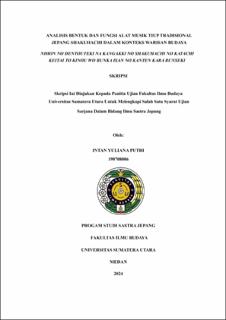Analisis Bentuk dan Fungsi Alat Musik Tiup Tradisional Jepang Shakuhachi dalam Konteks Warisan Budaya
Analysis of the Form And Function of the Traditional Japanese Wind Instrument Shakuhachi in the Context of Cultural Heritage

Date
2024Author
Putri, Intan Yuliana
Advisor(s)
Situmorang, Hamzon
Alimansyar
Metadata
Show full item recordAbstract
This research discusses the form and function of the traditional Japanese musical instrument Shakuhachi. Shakuhachi is a type of wind instrument that has been used since the Edo period. The purpose of this research is to describe the form and function of Shakuhachi in Myoan, Kinko and Tozan styles. This research uses descriptive qualitative method. The data collection technique uses the library method by collecting reading sources in the form of books as references related to culture and traditional Japanese musical instruments Shakuhachi, internet technology information and YouTube videos. The results showed that traditional Japanese wind instruments, with a focus on three main genres: Myoan, Kinko, and Tozan. Myoan and Kinko shakuhachi show similarities in material and type, but differ significantly in hole size and design, which affects the sound produced. The Shakuhachi myoan has long and asymmetrical holes, while the Kinko is more stable and without a center joint, exhibiting unique characteristics. Both have Utaguchi which favors a soft sound quality. Tozan Shakuhachi, on the other hand, differ in size and design, with symmetrical holes and Utaguchi that resembles a smiley face, adding to the cultural appeal. These design variations reflect the diversity within the Japanese musical tradition, with each genre offering its own distinctive sound and aesthetic. Myoan shakuhachi are commonly used for meditation and religious purposes. Shakuhachi kinko are used for solo performances, nihon-buyo performances and orchestral music. Shakuhachi tozan is used in terms of shakuhachi concerts, as well as celebrations.
Collections
- Undergraduate Theses [593]
